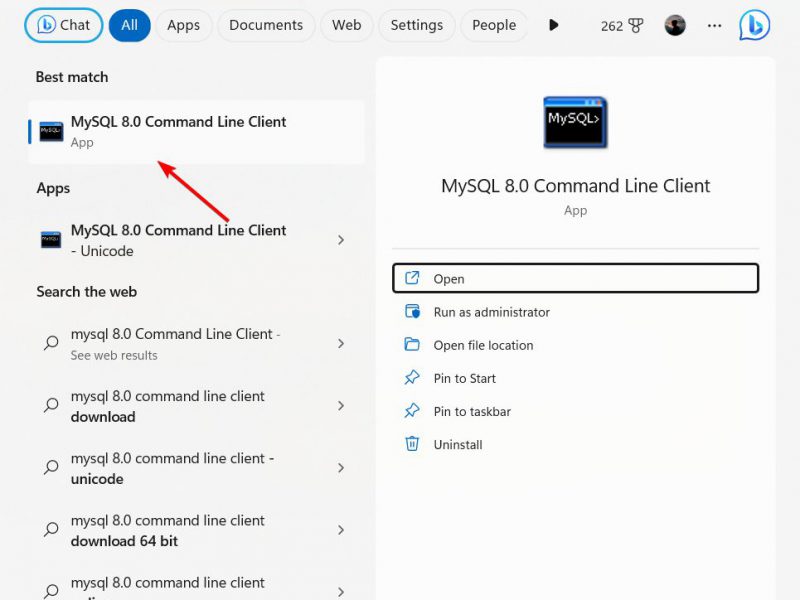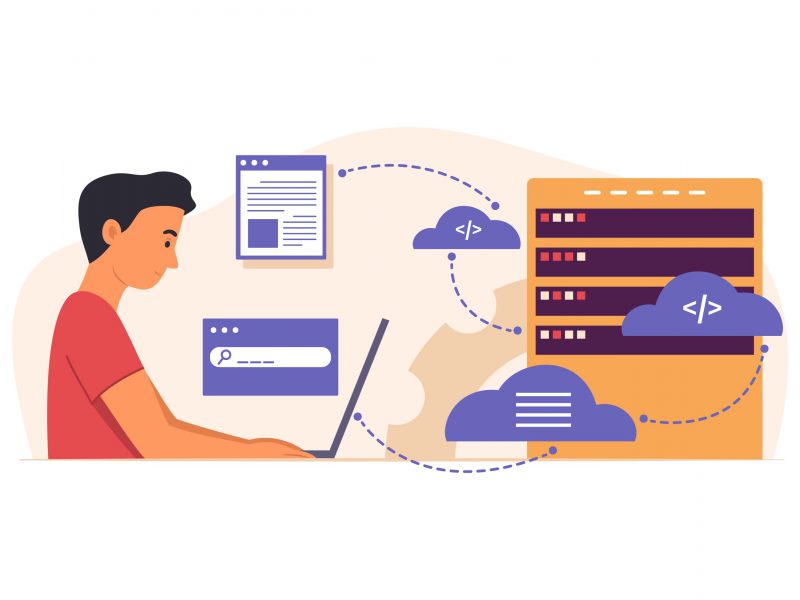Applications and analytics depend on relational database management systems (RDBMS) such as PostgreSQL and MySQL for data archiving, organization, and access. Popular open-source databases with extensive feature sets and lengthy histories are PostgreSQL and MySQL.
On the other hand, PostgreSQL and MySQL have different design philosophies and technical architectures. This guide will help you choose a database for your application if you’re having trouble deciding.
We examine PostgreSQL and MySQL’s technical, functional, and strategic distinctions. Now let’s get going.
A Synopsis Of MySQL And PostgreSQL
Before diving into the comparisons, let’s briefly introduce PostgreSQL and MySQL.
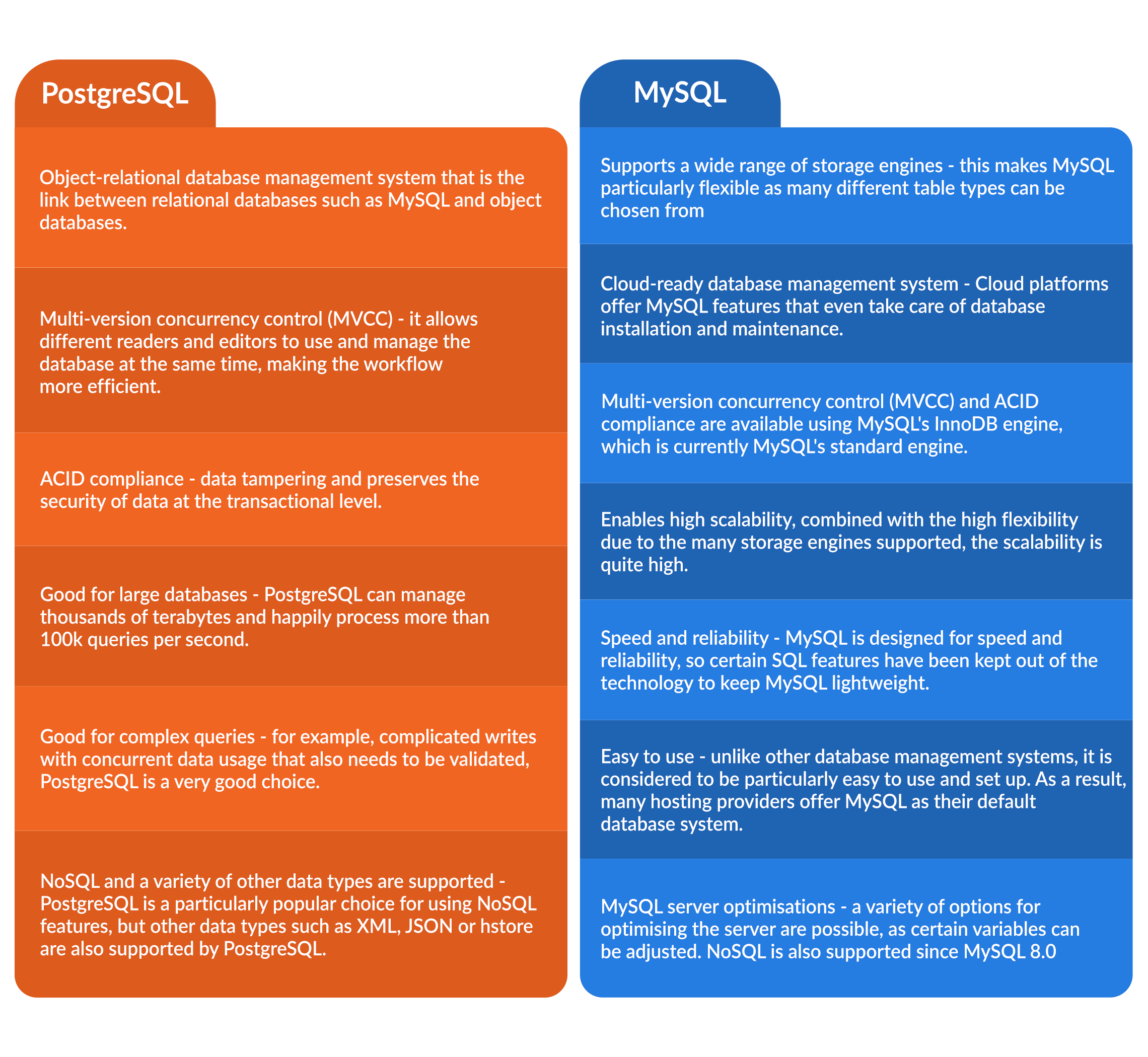
An open-source relational database at the enterprise level is called PostgreSQL. In a recent survey of 76,000 developers conducted by StackOverflow, PostgreSQL surpassed MySQL as the most popular database in 2024, with over 45% of the respondents using it.
PostgreSQL places a strong emphasis on proven architectures, extensibility, and standards compliance. Since its inception in 1986 at the University of California, Berkeley, the PostgreSQL project has evolved to include features that prioritize data integrity, robustness, correctness, and reliability.
Postgres employs a five-level system:
- Instance (also called cluster)
- Database
- Schema
- Table
- Column
Here’s an example of building a basic PostgreSQL users table and adding a few rows:
CREATE TABLE users (
user_id SERIAL PRIMARY KEY,
name VARCHAR(50),
email VARCHAR(100)
);
INSERT INTO users (name, email) VALUES
('Ian Jobs', '[email protected]'),
('Luke Smith', '[email protected]');
The Swedish startup MySQL AB launched the open-source RDBMS MySQL in 1995; Oracle later purchased MySQL. Historically, it has placed a high priority on simplicity, speed, and ease of use when creating embedded and web applications. MySQL is designed with speedy read and write performance in mind.
MySQL employs a four-level system:
- Instance
- Database
- Table
- Column
The user’s table can be created in MySQL as follows:
CREATE TABLE users (
user_id INT AUTO_INCREMENT PRIMARY KEY,
name VARCHAR(50),
email VARCHAR(100)
);
INSERT INTO users (name, email) VALUES
('Ian Jobs', '[email protected]'),
('Luke Smith', '[email protected]');
The only difference between the two queries, as you can see, is that the INT AUTO_INCREMENT has changed to SERIAL.
A Comparison of PostgreSQL and MySQL’s Performance
Although both PostgreSQL and MySQL are capable of achieving very high performance, one cannot say which is superior.
You won’t find any consistency between PostgreSQL and MySQL’s read/write performance tests. This is due to the fact that hardware configuration, database schema and indexes, and, most importantly, database configuration tuning, all have a significant impact on database performance. In essence, the workload and configurations of your application have a big impact on performance.
Workloads fall into five broad categories:
- CRUD: Simple READ, WRITE, UPDATE, and DELETE operations.
- OLTP: Transactional, complex operations of data processing.
- OLAP: Analytical batch processes.
- HTAP: Hybrid transactional and analytics processing.
- Time-Series: Time-series data with very simple, but high-frequency access patterns.
It’s well known that PostgreSQL can manage demanding OLAP and OLTP workloads with relative ease. These workloads involve long-running, incredibly complex queries that analyze large amounts of data, such as geospatial analysis or business intelligence queries.
For simpler CRUD and OLTP workloads requiring faster reads and writes, such as web or mobile applications, MySQL is generally a good choice.
Depending on your schema and server configuration, both databases can perform exceptionally well for hybrid workloads that combine OLTP and OLAP querying requirements.
PostgreSQL typically scales better to take advantage of the high memory, faster processors, and more cores available on the hardware when it comes to raw power on optimized hardware.
Read Performance
For applications, MySQL typically offers faster read times than write times. Nevertheless, PostgreSQL has caught up to the disparities in read speed following the most recent updates.
Due to the two systems’ different architectures, MySQL has an advantage in read performance because its storage engines are highly optimized for quick, single-threaded sequential access.
Of course, PostgreSQL can also provide outstanding read performance for a variety of applications with customized tuning and schemas. But MySQL often has an advantage right out of the box.
Write Performance
Everyone agrees that PostgreSQL performs better when it comes to writing performance, including bulk loads and intricate queries that alter data.
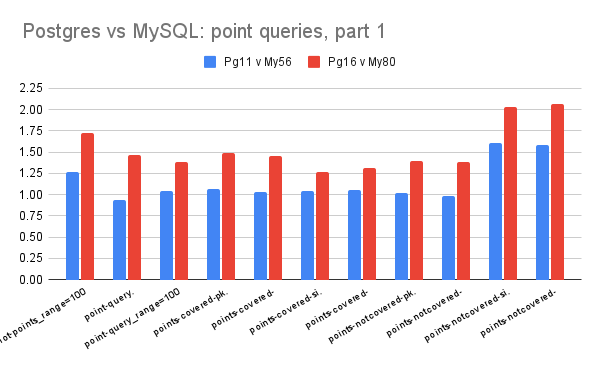
PostgreSQL’s multi-version concurrency control (MVCC) architecture offers a significant benefit in that it permits numerous sessions to update data concurrently with little to no locking.
PostgreSQL’s write throughput can outpace MySQL’s if your application needs to accommodate multiple users editing data at once.
Complex Query Performance
Additionally, PostgreSQL frequently outperforms MySQL in complex analytical queries involving large table scans, sorts, or analytics operations. In many cases, this difference is substantial.
PostgreSQL has the advantage of processing complex analytic queries more quickly due to its sophisticated SQL query optimizer and support for advanced SQL syntax. Although MySQL has greatly improved recently, it still depends more on hand-tuning queries.
Therefore, PostgreSQL frequently performs well for business intelligence or data warehousing needs where complex multi-table SQL performance is important.
Configuration Impacts Performance
Databases can, of course, be set up and optimized to accommodate various workloads. The “best” system will therefore still largely depend on the underlying server hardware, operating system, storage subsystem, database configuration, and schema design for any given use case.
BenchANT performs an excellent job of demonstrating how various servers can affect the performance of a database.
Furthermore, the hardware configuration has a big influence on how well your database performs. Your database operations will be incredibly fast if, for instance, you use a VPS with NVMe storage, since the underlying storage is far faster than a standard hard drive.
There isn’t a single fastest system, though; instead, your mileage will differ depending on your environment and tuning.
When to Use – PostgreSQL vs MySQL
In applications dominated by quick key-value read access and simple schemas, MySQL frequently performs better than PostgreSQL, consuming fewer system resources. MySQL’s advantages extend to web and mobile applications that have more demanding requirements for scalability, availability, and distributed reads.
For workloads needing flexible data types, business analytics querying, or intricate write-access patterns, PostgreSQL’s architectural advantages make it a worthwhile consideration. PostgreSQL offers a solid foundation for configuration and query optimization if you have database administrators on hand.
Feature Comparison – PostgreSQL vs MySQL
Although both databases have full feature sets, there are notable distinctions in the functions, supported data types, and overall feature sets.
| Feature | PostgreSQL | MySQL |
| Data Types | Robust built-in support for JSON, XML, arrays, geospatial, network, etc | It relies more on JSON extensions |
| Functional Languages | SQL, C, Python, JavaScript | Primarily SQL |
| GIS Support | Excellent via PostGIS spatial extension | Limited, often requires add-ons |
A wider range of native data types are supported byPostgreSQL, giving your database schemas greater flexibility:
- Geometric types for GIS systems
- Network address types like IPV4/IPV6
- Native JSON and JSONB – optimized binary JSON
- XML documents
- Array types
- Multi-data-type columns
MySQL offers more straightforward data entry, primarily for numeric, date/time, and string fields. However, JSON columns and spatial extensions can provide comparable flexibility.
Functional Languages
For increased flexibility, PostgreSQL enables functions and stored procedures to be written in a variety of languages, including SQL, C, Python, JavaScript, and more.
In contrast, application logic can be written in a variety of general-purpose languages, but MySQL stored routines need to be coded in SQL.
Therefore, PostgreSQL offers far greater flexibility if you need to incorporate application logic or intricate calculations directly into database procedures.
GIS Support
Through the PostGIS extension, PostgreSQL provides exceptional built-in functionality for spatial datasets used in mapping and geographic applications. Points-within-polygons, proximity computations, and location queries all function natively.
Unless you use a third-party spatial engine like MySQL Spatial or Integration MySOL, MySQL’s spatial support is even more constrained. PostgreSQL with PostGIS is typically a more capable, easier-to-use solution for GIS systems.
Replication
Replication is provided by both databases, enabling synchronization of database changes across instances. Since WAL (Write Ahead Log) files are the foundation of PostgreSQL replication out of the box, websites can be scaled to include as many database servers as they like.
Thus, PostgreSQL facilitates the fine synchronization of read replicas with changing portions of the data. Third-party tools might be required for MySQL.
Architecture And Scalability
The overall architectural differences between PostgreSQL and MySQL have an impact on their scalability and performance profiles.
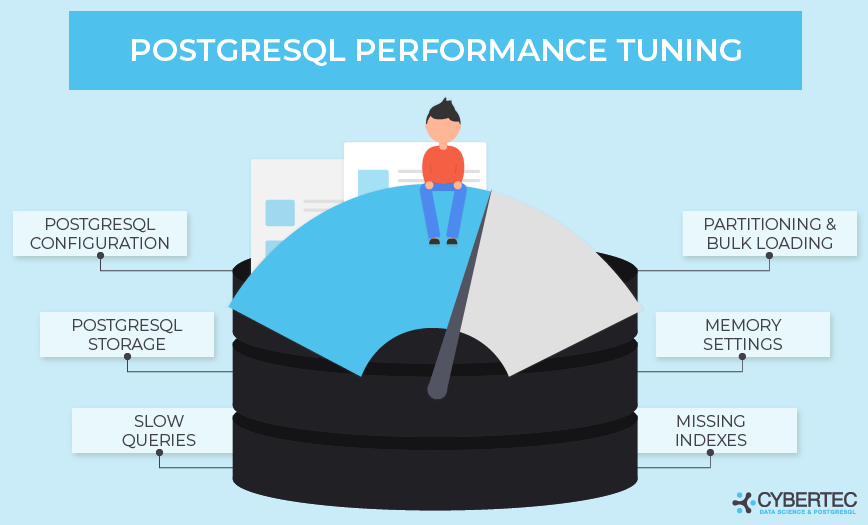
PostgreSQL’s Object-Relational Model
Adherence to the object-relational model, which allows data to adopt properties akin to objects in object-oriented programming, is a fundamental feature of the PostgreSQL architectural design. As an illustration:
- Tables can inherit properties from other tables.
- Data types can have specialized behaviors.
- Functions are features of data types.
Modeling complex real-world data closer to application objects and entities is made possible by this Object-Relational framework. But it has a price: tracking richer data relationships requires more complex internal systems.
Excellent flexibility is thus provided by the object-relational extensions, but there is a performance cost compared to a strictly relational system.
MySQL’s Pure Relational Model
MySQL, on the other hand, uses a purely relational model that is based on a straightforward data table schema and relations created by using foreign keys. This more straightforward model performs well for transactional workloads driven by websites.
Database customizations are not the best way to handle advanced MySQL usage with large JOIN operations or localized business logic; instead, application code should be used. MySQL’s core architecture prioritizes simplicity over flexibility.
MySQL lacks object-oriented features and is only a relational database, in contrast to PostgreSQL. Every database is made up of distinct tables devoid of custom types or inheritance. Recently, JSON has added some flexibility to document databases.
But while MySQL achieves better out-of-the-box performance in many workloads by eschewing object features, PostgreSQL offers deeper modeling capabilities that MySQL does not.
Therefore, PostgreSQL handles complexity better than MySQL, and MySQL is faster for simpler data. Select according to your needs for scaling and data access.
Write Scaling With Multiversion Concurrency Control (MVCC)
Horizontal write scaling is one area in which PostgreSQL shines, enabling numerous concurrent sessions to update data across distributed servers via the MVCC model.
Excellent concurrency is possible even for mixed read-write workloads with the help of the MVCC model, which enables PostgreSQL databases to scale extremely high throughput through replication. Writes start out in parallel and sync afterwards.
Instead of using MVCC, MySQL InnoDB uses row-level locking to achieve comparable concurrency. However, testing has shown that PostgreSQL’s architecture is more scalable with large write loads.
Dependability and Data Security: PostgreSQL vs. MySQL
Both PostgreSQL and MySQL offer strong security safeguards and robust reliability mechanisms; however, PostgreSQL prioritizes high availability while MySQL focuses on durability.
Access Control And Encryption
In addition, PostgreSQL and MySQL offer security features like network encryption, privilege management, and user account controls. The same applies to important items like role-based row-level security, password policies, and SSL connections.
There are a few variations regarding encryption, though:
- Native data-at-rest encryption: Pgcrypto, a module for file-system transparent tablespace encryption, was added to PostgreSQL 13. MySQL allows plugins but does not have native encryption.
- Lightweight row access policies: RLS and MASK in PostgreSQL allow roles to control row visibility through policies all the way down to data domains. Although MySQL isn’t as reliable, it can achieve a similar result by using views.
While SSL/TLS encryption is used for client connections to protect sensitive data in both RDBMS systems, PostgreSQL has a few more built-in access control options, activity monitoring, and encryption cipher algorithms than MySQL.
WAL-Based PostgreSQL Reliability
Write-ahead logging (WAL) is a feature of PostgreSQL that records changes to the data in the log prior to the data actually being modified.

This guards against database corruption and data loss even in the event of crashes or power outages.
PostgreSQL’s WAL logs preserve a coherent sequence of modifications queued across transactions, enabling speedy replay and data recovery.
Features like point-in-time recovery (PITR) to prior states in time, parallel queries, and streaming replication are powered by this mechanism, which eliminates the need for complete backups.
All things considered, WAL contributes to preserving data durability assurances and speed increases for crash recovery and replication.
MySQL High Availability
MySQL provides strong high-availability clustering that automatically switches over with the least amount of disruption in the event that one server crashes. Outages are rare because replicas are automatically promoted and resynchronized quickly.
High availability was not built into MySQL 5.7; instead, MySQL 8 introduced the InnoDB cluster, which allows for automated failover between nodes.
Replication tools like Slony, Londiste, or pgpool-II, which offer middleware or trigger-based failover, are another way that PostgreSQL achieves high availability. While PostgreSQL can achieve high availability, it does not have MySQL’s native clustering integration.
Therefore, MySQL’s built-in clustering features might be more suitable if your application requires 100% server uptime without the need for human intervention. This is also one of the reasons MySQL is still used by WordPress, a content management system that powers 43% of the internet.
Community Support And Libraries
Owing to their extensive user bases and lengthy histories, PostgreSQL and MySQL provide valuable resources such as third-party tools, documentation libraries, and forums. Still, a few distinctions are obvious.
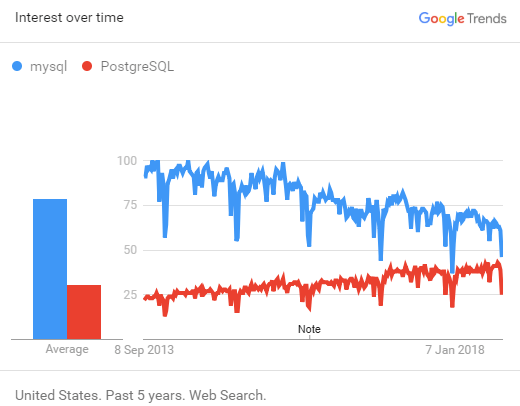
Google Trends indicates that interest in MySQL is gradually declining and moving more toward PostgreSQL. Nonetheless, both databases continue to enjoy strong community support due to their large user bases and loyal followings.
PostgreSQL Community
The PostgreSQL Global Development Group, a global collaboration of open community developers, oversees the development of PostgreSQL. Participating in the email lists, blogs, IRC channels, and events are thousands of users and contributors.
In order to periodically bring the Postgres community together, they also organize conferences like PGConf. Overall, PostgreSQL continues to advance thanks to a strong, competent support ecosystem.
MySQL Community
MySQL is a very well-liked open-source database that has support from the internet community. You can find extensive documentation and discussion boards for problem solving and next steps in the MySQL Developer Zone. Big events like Percona Live cover the most recent MySQL best practices.
It was also able to secure the much-needed funding for new releases and paid support services for users in need of further help thanks to Oracle’s acquisition of MySQL. MySQL users have excellent community resources, despite MySQL not being as grassroots as PostgreSQL.
Comparing Support Depth
Additionally, both databases have top-notch networks for community support. PostgreSQL offers superior technical guidance and documentation, considering the inherent complexity of the database. Unlike most tech documentation, theirs is also a little cheeky. This is a sample:
“The first century starts at 0001-01-01 00:00:00 AD, although they did not know it at the time. This definition applies to all Gregorian calendar countries. There is no century number 0, you go from -1 century to 1 century. If you disagree with this, please write your complaint to: Pope, Cathedral Saint-Peter of Roma, Vatican.”
— PostgreSQL Documentation on EXTRACT, date_part
The MySQL community provides more experience in refining entry-level use cases, such as web applications.
Expect active, supportive user communities for both databases, eager to contribute to usage and expansion.
Typical Use Cases
Considering the distinctions that have been discussed thus far, PostgreSQL and MySQL tend to be used for different purposes. Both RDBMS systems, nevertheless, frequently function flawlessly when reading and writing data rows for web applications.
PostgreSQL Use Cases
PostgreSQL excels at very data-heavy analytic workloads such as:
- Business intelligence utilizing intricate aggregate queries that span millions of rows.
- Data warehousing and reporting on numerous table JOINS and circumstances.
- Data science and machine learning need the array, hstore, JSON, and custom data types provided by PostgreSQL.
- Geospatial and multidimensional analysis through specialized processing and PostGIS. Geometry manipulation, satellite imagery, climate data, and real-time location data are a few examples.
These make use of PostgreSQL’s adaptability.
As big data analytics becomes more prevalent, there are numerous specific vertical use cases in the legal, medical, research, insurance, government, and financial sectors.
Examples from the real world are: Amtrak rail customer tracking; Reddit; Apple; Instagram; Skype call detail records; Johns Hopkins Hospital system genetics research; New York Times advertising analytics; Gap employee scheduling system; etc.
MySQL Use Cases
MySQL emphasizes the inherent scalability, ease of development, and speed of web and mobile applications. Specific advantages include:
- High-performance online transaction processing (OLTP) for web apps and e-commerce websites that require high throughput for reads and writes that touch multiple distinct tables in a row. Consider large, established websites like Uber, Airbnb, Twitter, and Facebook.
- Massively multiplayer online (MMO) games that need to support a large number of players simultaneously in almost real-time.
- Mobile applications and the Internet of Things (IoT) calls for small databases that can be embedded in edge devices or bundled locally, periodically syncing back to data centers.
- Software-as-a-service (SaaS) multi-tenant systems allow databases to be quickly scaled out on demand while maintaining data separation.
Deep analytics capabilities or data science tooling are not as important to these applications as availability and read/write speed at web scale. Uber likewise switched back from PostgreSQL to MySQL in 2016, which caused quite a stir in the tech community at the time.
WordPress, Wikipedia, Facebook, Google AdWords, Zendesk, Mint, Uber, Square, Pinterest, Github, Netflix movie browsing, YouTube video metadata, and many other large companies use MySQL.
Migrating From MySQL To PostgreSQL Or Vice Versa
Given the extensive usage of both databases, many developers may alternate between MySQL and PostgreSQL. What should they expect from this process of moving the database?
Most relational databases that are fully functional can be moved between MySQL and PostgreSQL with ease, thanks to the excellent migration tools that are currently available. SQL syntax and functions overlap far more than they differ. The majority of data types translate well, even though trial conversions are useful.
Let’s look at some crucial problems that need to be fixed:
Handling Data Type Changes
Consider the following when moving schemas from MySQL to PostgreSQL or the other way around:
- MySQL’s AUTO_INCREMENT columns become SERIAL in PostgreSQL.
- Since MySQL lacks a datatype that is comparable, PostgreSQL arrays require additional syntax modifications.
- Check date/time data conversions.
To ensure fidelity, test migrations against copies of the production data. Applications can be broken by data type mismatches if they are not fixed.
Stored Procedure Migration
Rewriting code is necessary when transferring stored procedures from MySQL to PostgreSQL if you mainly rely on them for business logic.
Code portability is often broken by significant differences in their procedural languages, such as delimiter syntax. Verify that permissions are still valid for production processes as well.
Thus, make sure your migration is fully validated and don’t assume that features will transfer across platforms seamlessly.
Client Compatibility
When changing environments, applications that depend on the PostgreSQL and MySQL client libraries also require reconfiguration:
- Update connection strings.
- Replace client library usage.
- Redirect API calls to a new platform.
Application changes are also necessary when making changes to the underlying database. Include the most recent connectivity in your checklist for migration testing.
Schema Changes From RDBMS Features
Compare MySQL views and triggers with PostgreSQL’s row-level security, table inheritance, and optimized user permissions to determine whether logic should be moved to the new, enhanced constructs offered by each database. Features that impact functionality typically migrate more smoothly and adhere to SQL standards.
Application Code Changes
Naturally, update the used drivers and connection strings. Optimize each database’s performance advantages as well. More app-side joins and presentation logic—which is currently only in SQL on PostgreSQL—may be used by MySQL. However, business rule approaches that were previously limited to MySQL triggers and stored procedures can now be implemented with PostgreSQL.
Thankfully, a lot of data access frameworks, such as Hibernate, limit exposed proprietary syntax, abstracting away some differences from developers. Consider whether ORM or client modifications are also logical.
In order to successfully utilize the best features that each database has to offer, migration stress can be reduced with careful planning, impact assessments, and staging environments.
Use Migration Tools
Thankfully, there are a few tools that make transferring data and schemas between PostgreSQL and MySQL easier:
- pgLoader: A well-liked tool for transferring data to PostgreSQL.
- AWS SCT: Database translator for migrations that are uniform.
They ensure that data is consistent across systems and automatically resolve a number of OS/environment compatibility problems.
Therefore, allow time for conversion and testing, but use automated tools to switch databases.
Which Database Is Best for You?
Your particular application requirements and team dynamics will play a major role in your decision between PostgreSQL and MySQL, but you can make some important decisions based on the following questions:
Which kinds of data are you going to store? PostgreSQL’s object-relational model and flexible data types make working with more intricate and linked data much easier.
How important is query scalability and performance? MySQL is a better throughput handler for web applications with high traffic volumes that require faster reads. However, PostgreSQL has shown to be more robust in mixed read-write workload scenarios at the enterprise level.
What administrative expertise is there on your team? PostgreSQL rewards extensive database knowledge because of its wide range of configuration options. For administrators who don’t have great SQL skills, MySQL is easier to get up and running.
Database server hosting is simple and easy with VPS, dedicated servers, and cloud hosting from platforms like ASPHostPortal. In order to simplify operations and free you up to concentrate on leveraging data for business insights, ASPHostPortal manages security and automated backups.
Our fully featured hosting already includes
- Easy setup
- 24/7/365 technical support
- Top level speed and security
- Super cache server performance to increase your website speed
- Top 9 data centers across the world that you can choose.

Javier is Content Specialist and also .NET developer. He writes helpful guides and articles, assist with other marketing and .NET community work


